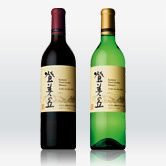 The Japanese have made wine for years; it is just that no one outside Japan wanted to drink it, particularly if it was sweet swill made from a native table grape called koshu.
The Japanese have made wine for years; it is just that no one outside Japan wanted to drink it, particularly if it was sweet swill made from a native table grape called koshu.
But Ernest Singer thinks koshu deserves a place among the world’s fine white-wine grapes.
Mr. Singer, a wine importer based in Tokyo, said koshu captured his imagination nearly a decade ago when he tasted an experimental dry white wine made from the grape. Light and crisp with subtle citrus flavors, it was a match for Japan’s cuisine, he said, and could become the first Asian wine to draw international recognition.
With grapes from local growers and expertise from France, he began making his own wine, seeking to help koshu reach its potential. Now he and a clutch of family-owned Japanese wineries working under the banner Koshu of Japan are racing one another to be the first to produce koshu good enough to succeed in the world market.
“We have shown you can make real wine in Japan,” Mr. Singer said. The question remains, he said, whether established vintners will change their winemaking practices or “continue to sell their schlock.
“The good news is that I’ve encouraged a small number of young winemakers,” he said. Even his chief rival, Shigekazu Misawa, the owner of Grace Wine and a leader of Koshu of Japan, said that without Mr. Singer, it was unlikely that anyone would even think of exporting koshu.
“It was Ernie’s idea to raise quality to improve the position of koshu in the world market,” Mr. Misawa said. “He knew that koshu could become a wine that represents Japan to the world.”
Ever since Japan discovered European and California wines during the 1970s economic boom, the country’s homegrown wines have been losing ground to imports. In the mid-1990s, a few Japanese winemakers began trying to make better wine with koshu.
Japanese fine-wine drinkers, however, are haunted by what koshu has been for the past 150 years. Found almost exclusively in Yamanashi Prefecture at the base of Mount Fuji, koshu is a tart, gray grape. Growers would dispose of damaged and rotten fruit by making wine with heavy doses of sugar.
Yet, while Japan’s climate, with rainstorms common throughout the summer and fall, conspires against most wine grapes, koshu is well suited to a wet world. It resists the rot that plagues vinifera grapes in Japan. Late ripening, it retains its natural acidity.
Mr. Misawa was one of the first Japanese vintners to reject the idea of sugary koshu.
“I am the fourth-generation owner of Grace Wine,” Mr. Misawa says. “Koshu is two-thirds of all of the wine we make. And we needed to make it better.”
Yet, while he and other vintners traveled to Europe and Australia to learn modern winemaking methods, progress was slow. Viticulture methods from dry regions did not translate. And no one outside Japan had ever heard of koshu (a hybrid of vitis vinifera — the species responsible for the world’s most popular wines — and an unidentifiable wild variety, according to DNA research at the University of California, Davis).
“I learned to make wine here,” said Mr. Koki Oyamada, the winemaker at Chateau Lumiere, affiliated with Koshu of Japan. A new generation is pioneering new methods, he said. “We support each other, discuss problems, find solutions. We are improving quality.” After his first taste of dry koshu, Mr. Singer gambled big on it, flying in Denis Dubourdieu, professor of enology at the University of Bordeaux, to work on his first four vintages (2004 to 2007), which were made at Mr. Misawa’s winery with grapes he helped provide. To secure a steady supply of high-quality fruit, Mr. Singer leased land in three central Japan prefectures and now has nine koshu vineyards, a huge landholding for a nonfarmer in Japan.
Mr. Singer’s confidence in koshu is due in no small part to the wine critic Robert M. Parker Jr. The two men have worked together since 1998 when Mr. Parker hired Mr. Singer to be his representative in Asia. Mr. Parker tasted Mr. Singer’s 2004 koshu at the Grace winery in December 2004 and gave it a score of 87/88 on a scale of 100 in what Mr. Parker refers to as “an educational tasting.”
That first vintage was produced with grapes grown on old-fashioned pergola trellises. The canopies of these vines can stretch 50 feet in all directions from a mother vine the size of a tree. Mr. Singer says that his new vineyards, which are planted with vines planted closely together in neat rows with new shoots trained up, a system common in Europe and America, are producing smaller grapes with more-concentrated flavors that will make even better wine.








 The Japanese have made wine for years; it is just that no one outside Japan wanted to drink it, particularly if it was sweet swill made from a native table grape called koshu.
The Japanese have made wine for years; it is just that no one outside Japan wanted to drink it, particularly if it was sweet swill made from a native table grape called koshu.